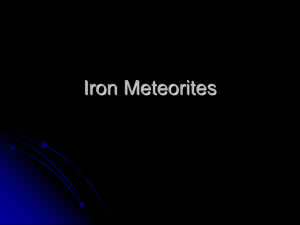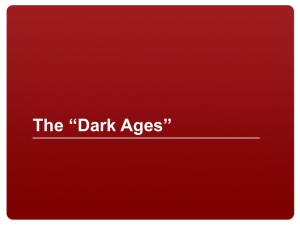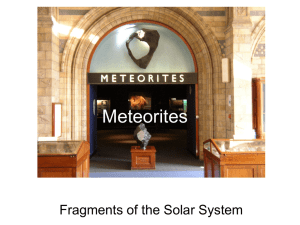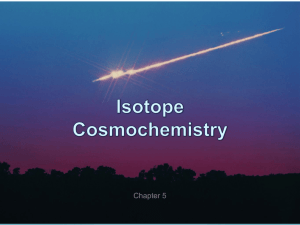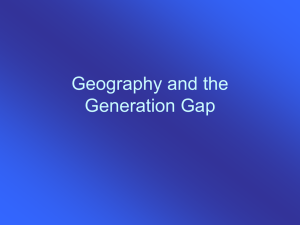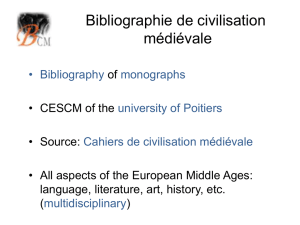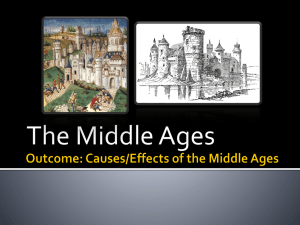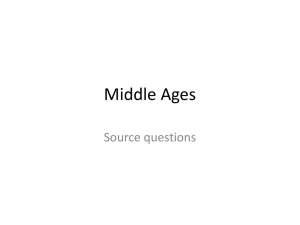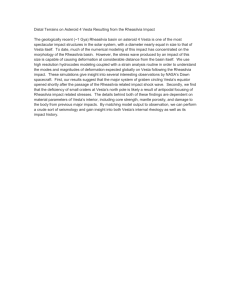Lecture 41
advertisement
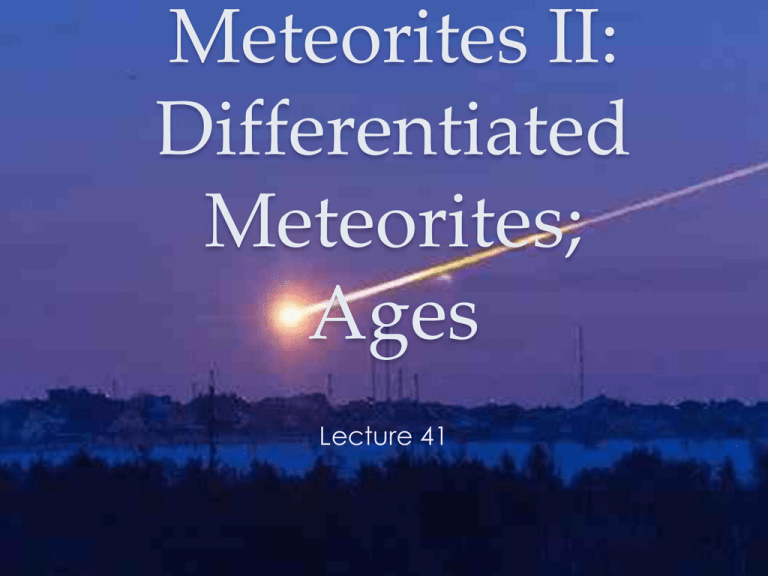
Meteorites II: Differentiated Meteorites; Ages Lecture 41 Chondrites Abee (EH4) note brecciation Chelyabinsk (LL5) Allende CV3 Ivuna (CI1) Achondrites • Achondrites are fundamentally igneous rocks formed by crystallization of melts on asteroidal parent bodies. o o • • • both intrusive and extrusive types. Like chondrites, can be brecciated. Most common group is the HED (Howardites, Eucrites, Diogenites) meteorites, which come from Vesta. Also include the SNC meteorites from Mars. Primitive achondrites: bulk compositions approximately chondritic, but texturally modified by partial melting or metamorphic recrystallization. Eucrite in thin section Aubrite Aubrites are related to enstatite chondrites. Brecciation is common in both chondrites and achondrites. 4 Vesta • • • Dawn spacecraft orbited Vesta for a year mapping the surface. Spectral analysis confirmed its surface composition matches that of the HED meteorites, which was long suspected. Dawn is now on its way to 1 Ceres. Vesta Spectral Map • • • • Blue shows eucrite (basalt). Cyan areas show regions with eucrite and howardite (breccias). Red areas: diogenite (intrusive cumulates). Yellow areas: diogenite and howardite. Irons • • • • Irons are mostly remnants of the once molten metal cores of disrupted asteroids. Some irons (IAB’s) crystallized from molten metal that segregated from silicate liquid in impact melts. Originally classified on basis of texture (a function of Fe/Ni ratio), they are now classified by composition (originally by Ga-Ge-Ni concentrations). Each class from a different parent body. Chemical variation within class reflects fractional crystallization. Stony-Irons • Pallasites: o a network of Fe-Ni metal with nodules of olivine. They probably formed at the interface between molten metal and molten silicate bodies, with olivine sinking to the bottom of the silicate magma. • Mesosiderites: o The silicate portion is very similar to diogenites – brecciated pyroxene and plagioclase – and a genetic relationship is confirmed by oxygen isotopes. The metal fraction seems closely related to IIIAB irons. It is possible they formed as the result of a collision of two differentiated asteroids, with the liquid core of one asteroid mixing with the regolith of the other. Time Zero • • • • • As we noted, CAI’s are the oldest known objects. The oldest is a CAI from NWA2364 (CV3) with a Pb-Pb age of 4568.67 ± 0.17 Ma. The next oldest ages are 4567.59 ± 0.11 Ma for a CAI from Allende and 4567.11 ± 0.16 Ma for a CAI from Efremovka; both also CV3’s. These ages may need slight revision due to variable 235U/238U (possibly due to decay of 247Cm) observed in meteorites. Oldest age with measured 235U/238U is 4567.18 ± 0.50 Ma for an Allende CAI. This range of ages could reflect aqueous alteration on parent bodies. Other Pb-Pb Ages • Pb-Pb ages provide the most accurate ages of meteorites o ages are on U-rich phases such as CAI’s and phosphates. • Range of high precision ages is ~70 Ma, which includes processing in parent bodies. o K-Ar ages range down to 4.4 Ga and reflect impact events. • Achondrites are surprisingly old. o Oldest high-precision Pb-Pb age is 4564.42 ± 0.12 Ma for the angrite D’Orbigny. o Oldest HED meteorite is Ibitira, a eucrite with an age of 4556 ± 6. Extinct Radionuclides • There is abundant and compelling evidence that certain short-lived nuclides once existed in meteorites. o This evidence consists of anomalously high abundances of the daughter nuclides in certain meteorites, and fractions of meteorites that correlate with the abundance of the parent element. The first of these to be discovered was the 129I–129Xe decay (Reynolds, 1960). o o o Provides evidence of nucleosynthesis shortly before the solar system formed. Provides a means of relative dating of events in the young solar system Provides a source of energy to heat and differentiate early solar system bodies (26Al particularly). o • Significance is 3-fold: Dating with Extinct Radionuclides • Consider 53Cr/52Cr plotted as a function of the 55Mn/52Cr. Provided that (1) all minerals formed at the same time, t=0, (2) all remained closed to Mn and Cr since that time, and (3) 53Mn was present when they formed and has since fully decayed, • • • • We can derive the following equation from the fundamental equation of radioactive decay: æ 53Cr ö æ 53Cr ö æ 53 Mn ö æ 55 Mn ö çè 52 Cr ÷ø = çè 52Cr ÷ø + çè 55 Mn ÷ø çè 52Cr ÷ø 0 0 where the subscript 0 denotes the ratio at the initial time. On the plot, the slope is (53Mn/55Mn)0. (53Mn/55Mn), of course, decrease through time: early formed objects will have higher (53Mn/55Mn)0 than later formed ones. o Assuming the solar system began with some uniform initial (53Mn/55M, we can assign objects relative (but quantitative) ages because we know the rate of decay of 53Mn. 26Al • 26Al is particularly significant because of its short half-life (0.73 Ma) and it’s abundance: • o It allows a detailed chronology of the earliest objects in the solar system. o It was abundant enough in the early solar system to provide a significant source of heat: partly responsible for differentiated of early-formed objects such as Vesta. 26Al is produced in a type of red-giant star (AGB stars) - as is known both from theory and (γ-ray) spectral observation. Solar System Chronology • We can calibrate the extinct radionuclide time scale with Pb-Pb dating to produce an absolute chronology. • Important points: o CAI’s are the oldest objects o Chondrule formation seems to follow CAI formation by ~2 Ma. o Parent bodies of achondrites, such as Vesta formed, melted and differentiated within 5 Ma of time 0. They crystallized over an additional ~5 Ma period (e.g., angrite parent body). ‘Cooling ages’ of iron meteorites deduced from diffusion profiles are consistent - perhaps stretching cooling times to 10 Ma. Exposure Ages • Exposure ages of stones are even younger than those of irons, telling us meteorites were part of larger bodies until quite recently. • Continual gravitational disruption of asteroid orbits produces collisions and a flux of debris into Earth-crossing orbits. • We can classify asteroids based on spectral reflectance and make potential identification of these parent bodies.

